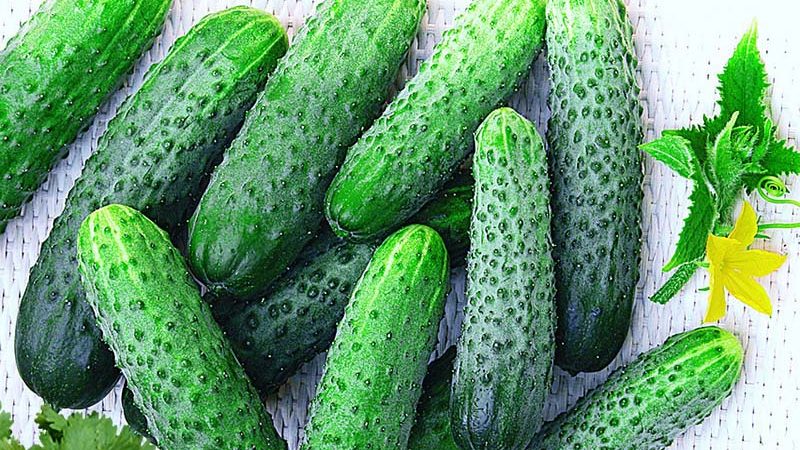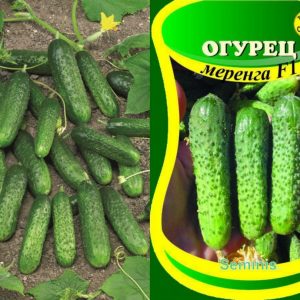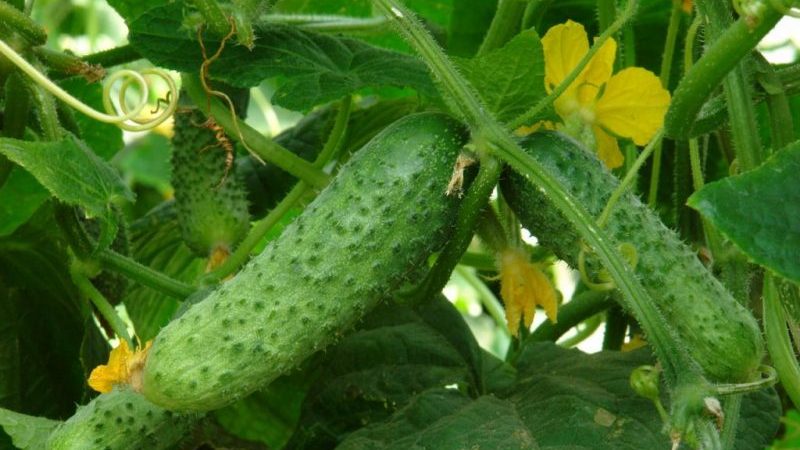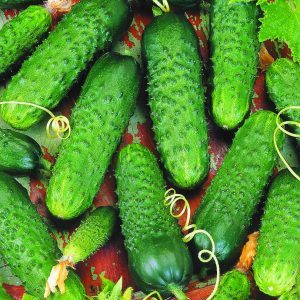Hybrid early ripe hybrid of cucumbers "Merenga", resistant to diseases and weather conditions
The Merengue F1 hybrid was developed by Dutch breeders. The culture quickly took root in the Russian regions. It is resistant to many diseases, unpretentious, gives a stable harvest with excellent commercial qualities.
One of the main qualities of the hybrid is the genetically determined absence of bitterness even when overripe. Read about these and other advantages of Meringue F1 in the article.
The content of the article
Description of cucumbers
The hybrid was bred by the Dutch company Monsanto, and Seminis is engaged in the production of its seeds. In 2007 it was entered into the state register of Russia. Over the past years, it has shown excellent results both in terms of yield and stability in the Russian climate.
Distinctive features

Main characteristics:
- parthenocarpic hybrid;
- resistance to deformation and overripening;
- early ripening of fruits;
- resistance to transportation;
- immunity to powdery mildew and peronosporosis;
- a small amount of seeds;
- lack of bitterness.
Composition, properties, benefits, calories
Like other cucumbers, 90-95% of the fruit is water. It also contains beta-carotene, vitamins A, C, PP, group B, potassium, magnesium, manganese, zinc, copper, iron, chlorine, iodine, chromium, phosphorus, sodium, folic acid. Due to the high fiber content, cucumbers enhance intestinal motility and gently cleanse it.
The average calorie content is 10-15 kcal per fruit.
Specifications
The hybrid is parthenocarpic, that is, it does not require insect pollination. Suitable for growing both outdoors and indoors. Tall plants with few lashes... Leaves are small, bright green, slightly pubescent, formed in small quantities, which facilitates harvesting. The flowers are bright yellow, female, up to 3-4 in one node.
The fruits are cylindrical, even, without curvature, with large tubercles and white spines. The color is dark green at the stem and brightens to pale green towards the flower. The average length is 8-10 cm, the average weight is 80-100 g. The pulp is sweet, without bitterness, even with prolonged growth. Not prone to yellowing, overgrowing and shrinking. There are few seeds, all of them do not carry parental characteristics.
The yield depends on the type of cultivation. In the open field, it is 10-12 kg per sq. m, in a greenhouse - 13-15 kg per sq. m.
How to grow this cucumber yourself
Like most varieties and hybrids, the Meringue F1 has a number of planting and grooming requirements. He prefers clay soils, where onions, tomatoes, potatoes or cabbage were previously grown.
For better growth and fruiting, it is recommended to fertilize the soil with a large amount of humus (100 kg per 10 sq. M) or add superphosphate and nitrogen (420 g and 270 g, respectively, to the same area). It is not worth using organic and mineral fertilizers at the same time; it is better to give preference to one thing. Top dressing is applied in the fall during digging or in the spring after the snow melts.
Reference! Some gardeners spread fertilizer on the melting snow - the melt water will carry the fertilizing with it to the required depth.
Planting by seed and seedling method
There are two ways to plant Meringue F1 cucumbers. The seed method, also called direct, saves time and effort, and with seedling, farmers get the harvest 1-2 weeks earlier.
For direct sowing, small holes 2.5-3 cm deep are prepared at a distance of 10-15 cm from each other. The minimum distance between the rows is 50-60 cm. 1-2 seeds are placed in one hole and sprinkled with soil. To accelerate germination, the hole is covered with a film or plastic can to create a greenhouse effect, as well as in case of the dangers of night frosts.
Reference! You can use the nesting method of planting, in which four seeds are planted in one hole along the perimeter.
The seedling method accelerates the growing season and fruiting period. Seeds are planted in containers at least 10 cm high. These can be both plastic containers for seedlings and peat pots. The latter are more acceptable - the variety does not tolerate transplantation and interference with the root system.
For sowing, use a special soil or prepare a substrate from sawdust, peat and humus in a 1: 2: 2 ratio. For 10 kg of substrate add two tablespoons of wood ash and the same amount of "Nitroammofoski". The containers are filled with the substrate by two-thirds, one seed is sown in each compartment or pot.
Seedlings are planted in the ground 25-30 days after the appearance of the first leaves.
Growing in stages and care
The first loosening is carried out after the germination of 1-2 leaves. The greenhouses are cleaned, the soil is loosened at a distance from the crops so as not to hurt the root system. Loosening is carried out both in the holes and in the distance between them.
The first dressing after planting seeds in a direct way is carried out after the appearance of the first true leaves. Mullein or mineral compositions are used as fertilizer - the choice depends on which type was applied in autumn or spring. If organic matter has already been introduced before planting, minerals are added and vice versa. Weak or damaged shoots are removed before feeding.
The working solution is prepared from one part of the mullein and five parts of settled water. Use rainwater or pre-prepared melted snow. For one plant, use 0.5 liters of solution. For mineral feeding, 20 g of nitrate and 20 g of potassium phosphate are used, which are diluted in 10 liters of water. The solution consumption is the same as in the case of organic fertilization. The second feeding is applied in 14-17 days.
Before flowering, the culture is watered with warm, settled water in a volume of 2-3 liters per plant. It is important to ensure that the soil is well aerated and drained, and that the water does not stagnate for a long time - this can cause root rot. From the beginning of flowering and during the fruiting period, the volume of water is increased to 5-6 liters per plant.
Important! Watered in the evening and at the root.
When the plants reach a height of 1 m, they are provided with support in the form of a trellis. In the nesting method, a support is installed in the center of the hole, to the upper end of which long twines are tied according to the number of plants in the hole. The free ends are pulled and tied to small pegs that are inserted into the ground next to the trunk.
Pinching and pinching is at the discretion of the grower. For better lighting of the bushes, it is recommended to pinch them and thin them out. Lateral shoots and flowers are removed from an adult plant at a height of 50-60 cm. The pinching is carried out on lashes 1.5 m long.
Features of cultivation and possible difficulties

The hybrid does not grow well on salty soils with poor aeration and prolonged stagnation of water. With excessive watering the roots begin to rot, and the plant begins to ache and may die.
With excess fertilization with nitrogenous dressing fruits lose their taste and acquire a bitter taste. These cucumbers are not suitable for canning. In addition, with an excess of nitrogen, leaves and shoots grow, and not flowers and fruits. With a lack of minerals or organic matter, shoots grow slowly, flowering practically does not occur.
The hybrid responds well to regular loosening and weeding. It is advisable to pull out weed plants by the root, and not to tear off the upper part.Simultaneously with weeding, a deeper loosening of the soil also occurs, since together with the roots of the weeds, substances useful for the culture are carried closer to the surface.
Diseases and pests
The hybrid is resistant to powdery mildew, peronosporosis and some other diseases. However, the Meringue F1 has little resistance to root rot, anthracnose, white rot and attack by spider mites, aphids and whiteflies.
Control and prevention methods:
- When attacked by a spider mite a characteristic white cobweb bloom appears on flowers and leaves. The pest feeds on plant juices. It is almost impossible to notice with the naked eye. The leaves begin to turn yellow and curl, and the flowers do not form ovaries. For insect control, insecticides such as Apollo, Nisoran or Oberon are used. Most often it affects plants in greenhouses.
- Anthracnose - fungal infection, manifested in violation of the temperature and irrigation regime. Signs of damage: the appearance of yellow-brown spots on the leaves, darkening and shrinking of the fruits, rotting them on the root. For the treatment of plantings, all the bushes are treated with a solution of bleach. A solution is prepared from 40 g of the substance diluted in 10 liters of water. If necessary, the treatment is repeated after 10-12 days.
- Root rot - a fungal disease that affects the root system and causes its death. It appears when the soil is contaminated with fungal spores, poor-quality seed or lack of proper pre-planting treatment. A characteristic feature is the darkening of the root collar of the plant. Affected seedlings are removed and burned, and the soil is treated with a solution of bleach. The well of the removed plant is disinfected with a solution of potassium permanganate.
Harvesting and application of the crop
The fruits can be harvested already at the gherkin stage. More mature fruits are harvested every 2-4 days as they ripen. Despite the fact that the hybrid is resistant to over-ripening, ready-to-harvest fruits take away nutrients from young cucumbers and inhibit their growth.
Gherkins and ripe fruits are suitable for fresh consumption, pickling and pickling. Fresh fruits are stored for up to 2-3 weeks.
Advantages and disadvantages
Pros:
- insects are not needed for pollination;
- early ripening and amicable ripening of fruits;
- stable yield;
- high portability;
- good taste.
Main disadvantages:
- instability to anthracnose;
- sterile seeds.
Reviews
Crops of Dutch origin are deservedly popular with Russian farmers.
Maria, Tula: “I have been planting Meringue in the greenhouse for quite some time. I am always happy with the hybrid - fast and friendly ripening, good yield and tasty fruits. I always grow through seedlings, but I make sure that the sprouts do not outgrow, they do not stretch. "
Alexander, Barnaul: “I don't really trust new hybrids - they are not designed for the Siberian climate. I tried Meringue as an experiment and was pleasantly surprised. The yield is incredible, the taste is excellent. The wife let part of the harvest for conservation - the cucumbers are crispy, fragrant, do not soften in the marinade. I will certainly plant further. "
Conclusion
Meringue F1 is an optimal hybrid for cultivation, with good health and unpretentious. With his qualities he is gradually winning over Russian household plots, even despite the prejudices of some vegetable growers regarding hybrids.
A stable harvest with good marketable qualities will allow you to eat fresh cucumbers all summer and make preparations for the winter.